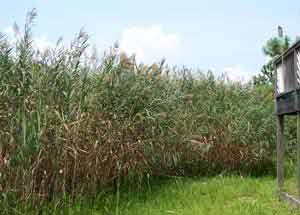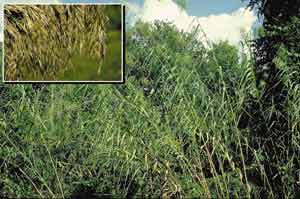Phragmites in South Carolina
Phragmites  is a emersed perennial plant that can reach 10 - 12 feet in height and
shade out shorter native vegetation. It can grow along the shorelines
of water bodies or in water several feet deep. In South Carolina, it
is restricted to the outer coastal plain where it occurs in fresh,
brackish and salt marshes and along streams, rivers and estuaries.
This plant is a native of the US and is normally not problematic.
However, there is an introduced European genotype of the plant which
is highly invasive. Recent research has shown that both native and
introduced species of Phragmites currently exist in North America.
is a emersed perennial plant that can reach 10 - 12 feet in height and
shade out shorter native vegetation. It can grow along the shorelines
of water bodies or in water several feet deep. In South Carolina, it
is restricted to the outer coastal plain where it occurs in fresh,
brackish and salt marshes and along streams, rivers and estuaries.
This plant is a native of the US and is normally not problematic.
However, there is an introduced European genotype of the plant which
is highly invasive. Recent research has shown that both native and
introduced species of Phragmites currently exist in North America.
Identification: Leaves grow alternately and are two-ranked, flat, long-attenuate up to
1 1/2 feet long and 1/2 inch wide. They are blue-green in color with
rough margins. The leafy  stem
is topped by a 1 foot long silvery brown silky panicle of flowers
(shown in inset). It is capable of reproduction by seeds, but spreads
primarily by underground stems called rhizomes. Growth patterns are
very dense and can "crowd" out native plants which causes major
ecological problems.
stem
is topped by a 1 foot long silvery brown silky panicle of flowers
(shown in inset). It is capable of reproduction by seeds, but spreads
primarily by underground stems called rhizomes. Growth patterns are
very dense and can "crowd" out native plants which causes major
ecological problems.
Phragmites infestations have impacted shallow water habitat in the Winyah Bay/Santee Delta area for over three decades. The S.C. Department of Natural Resources (DNR) has battled Phragmites in its waterfowl impoundments for most of that time with limited success, but the release of a new and more effective herbicides, imazapyr and imazamox, has encouraged the agency to increase control efforts.
Go here for more detail:
2007 - 2009 Phragmites control details and maps
2005 - 2006 Phragmites control details and maps
Winyah Bay Invasive Species
Phragmites Cost Share Information

